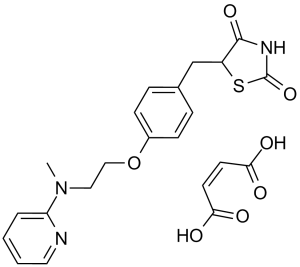This product is for research use only, not for human use. We do not sell to patients.

| Size | Price | Stock |
|---|---|---|
| 2g | $450 | Check With Us |
| 5g | $850 | Check With Us |
| 10g | $1275 | Check With Us |
Cat #: V0824 CAS #: 155141-29-0 Purity ≥ 99%
Description: Rosiglitazone maleate (TDZ01; HSDB-7555; TDZ-01; BRL-49653; trade name Avandia), the maleic acid salt form of rosiglitazone which is an approved anti-diabetic drug, is a thiazolidinedione-based antihyperglycaemic agent with antidiabetic properties and potential antineoplastic activity.
Publications Citing InvivoChem Products
Product Promise

- Physicochemical and Storage Information
- Protocol
- Related Biological Data
- Stock Solution Preparation
- Quality Control Documentation
| Molecular Weight (MW) | 473.5 |
|---|---|
| Molecular Formula | C18H19N3O3S.C4H4O4 |
| CAS No. | 155141-29-0 |
| Storage | -20℃ for 3 years in powder formr |
| -80℃ for 2 years in solvent | |
| Solubility In Vitro | DMSO: 94 mg/mL (198.5 mM)r |
| Water: <1 mg/mLr | |
| Ethanol: <1 mg/mL | |
| SMILES Code | O=C(N1)SC(CC2=CC=C(OCCN(C)C3=NC=CC=C3)C=C2)C1=O.O=C(O)/C=CC(O)=O |
| Synonyms | BRL 49653; BRL49653; BRL-49653; Rosiglitazone Maleate; Avandia; Avandaryl; BRL-49653C; BRL49653C; BRL 49653C; BRL-49653-C; |
| Protocol | In Vitro | Rosiglitazone maleate is a potent and selective activator of PPARγ, with EC50s of 30 nM and 100 nM for PPARγ1 and PPARγ2, respectively, and a Kd of appr 40 nM for PPARγ. Rosiglitazone (BRL49653, 0.1, 1,10 μM) promotes differentiation of C3H10T1/2 stem cells to adipocytes. |
|---|---|---|
| In Vivo | Rosiglitazone (5 mg/kg, p.o.) decreases the serum glucose in diabetic rats. Rosiglitazone also decreases IL-6, TNF-α, and VCAM-1 levels in diabetic group. Rosiglitazone in combination with losartan increases glucose compared to diabetic and Los-treated groups. Rosiglitazone significantly ameliorates endothelial dysfunction indicated by a significantly lower contractile response to PE and Ang II and enhancement of ACh-provoked relaxation in aortas isolated from diabetic rats. |
| Solvent volume to be added | Mass (the weight of a compound) | |||
|---|---|---|---|---|
| Mother liquor concentration | 1mg | 5mg | 10mg | 20mg |
| 1mM | 2.1119 mL | 10.5597 mL | 21.1193 mL | 42.2386 mL |
| 5mM | 0.4224 mL | 2.1119 mL | 4.2239 mL | 8.4477 mL |
| 10mM | 0.2112 mL | 1.0560 mL | 2.1119 mL | 4.2239 mL |
| 20mM | 0.1056 mL | 0.5280 mL | 1.0560 mL | 2.1119 mL |
This equation is commonly abbreviated as: C1 V1 = C2 V2
- (1) Please be sure that the solution is clear before the addition of next solvent. Dissolution methods like vortex, ultrasound or warming and heat may be used to aid dissolving.
- (2) Be sure to add the solvent(s) in order.




































